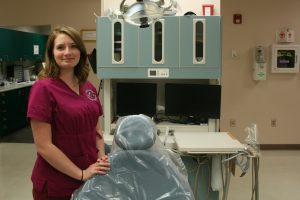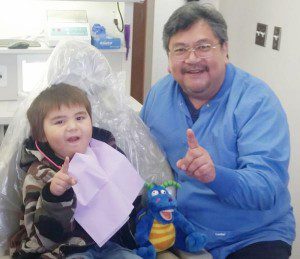
#DentalTherapistThursdays: Arielle Cawston, Colville
We Are Healers: Learn more about the Alaska Dental Therapy Education Program
We Are Healers: Meet Trisha Patton, DHAT Instructor and Practitioner!
 Dental Therapy 2020 Legislative Wrap-up
Dental Therapy 2020 Legislative Wrap-up
Thank you to everyone who continues to be involved in statewide dental therapy licensing bills in Oregon and Washington. Our Tribes continue to provide leadership, expertise, and resources to ensure we move closer to closing the gap in oral health care disparities in the Portland Area. Look forward for more opportunities to be involved in policy development and lobbying efforts in the next few months!
Oregon: A statewide dental therapy bill was introduced and had one hearing in Senate Health Care and did not move forward. In a short 35-day session (that resulted in virtually no bills passing because of legislators walking out early) we knew going in this would likely be the year we introduced bill for further work next legislative session. Senator Monnes Anderson, chair of the Senate Health Care committee is establishing a work group that will meet 4 times before next legislative session to make sure accurate information is offered, and that many of the questions that came up can be resolved before the bill is renegotiated and introduced again. There will be legislators and stakeholders represented on the work group. NPAIHB and our Pilot Project #100 Tribal Partners have requested to be represented.
We go into the interim with a strong coalition, a great starting place in the bill language drafted this year, and extensive coverageof the issue and the bill in media markets across the state.
Washington: The statewide licensing bill did not move out of the House again this session, so we will start over in Washington as well. We continue to play a leadership role in the Washington Dental Access Campaign and will be helping to reshape the effort in the next few weeks after exploring strengths and weakness and how best to move resources into those strategic campaign areas that need it.
If you have questions or ideas or interest in becoming more involved, please contact Pam Johnson, Native Dental Therapy Initiative Project Manager, pjohnson@npaihb.org.
Previously passed dental therapy legislation:
Washington State Law, 2017
Enrolled SSB 5079: Dental Health Services in Tribal Settings–Dental Health Aide Therapists
Oregon State Law, 2011
Enrolled SB 738: Dental Pilot Projects
Idaho State Law, 2019
S 1129: Amending Idaho Code to Provide for Dental Therapists
What is a Dental Pilot Project?
Dental Pilot Projects are an Oregon state initiative to encourage the development of innovative practices in oral health care delivery systems with a focus on providing care to underserved populations. The Oregon Tribes Dental Health Aide Therapist Pilot Project is demonstrating how this primary oral health care provider can increase access and quality of care to Oregon’s AI/AN population.
Where are Oregon DHAT’s practicing?
The pilot project, sponsored by the Northwest Portland Area Indian Health Board has three current sites: The Coquille Indian Tribe, Confederated Tribes of Coos, Lower Umpqua and Siuslaw Indians, and Native American Rehabilitation Association. All three sites have students in training, and there are two DHATs currently in practice: Naomi Petrie at CTCLUSI and Ben Steward at NARA Dental Clinic.
Download Oregon Tribes DHAT Pilot Project Fact Sheet here!
News Release: Tribes Bring Dental Therapy to Oregon
July 19, 2017–Naomi Petrie, a member of the Confederated Tribes of Coos, Lower Umpqua and Siuslaw Indians, started providing services this week as the first dental health aide therapist (DHAT) to practice in Oregon. She recently graduated from the Alaska Native Tribal Health Consortium DHAT Education Program, where she spent the past 2 years learning the most common preventive and routine restorative care needed at her tribe’s clinic in Coos Bay. Download press release here.


The mission of the Native Dental Therapy Initiative is to connect tribal communities with innovative approaches to address AI/AN oral health disparities, to remove barriers impeding the creation of efficient, high quality, modern dental teams and to provide opportunities for AI/AN people to become oral health providers. There is a tremendous opportunity to increase access to oral health care and improve oral health outcomes by training and employing Dental Health Aide Therapists (DHATs). DHATs are highly-trained primary oral health care providers. Part of a dentist-led team, they have a narrow scope of practice, focusing on routine and preventive services. They are recruited from their communities and go back to serve their communities. Tribes deserve the reliable, culturally relevant care that DHATs offer. The Native Dental Therapy Initiative is working to ensure this solution is available to all Tribes in the Portland Area.
Download NDTI Fact Sheets:
DHATs: Good for Tribal Economies
Additional Fact Sheets, Reports and Studies:
Pew Charitable Trusts, June 2019. Dental Therapy Seen as Best Practice in Boosting Access to Care
University of Washington, Donald L. Chi, DDS, PhD, August 2017: Dental Utilization for Communities Served by Dental Therapists in Alaska’s Yukon Kuskokwim Delta: Findings from an Observational Quantitative Study
American Journal of Public Health: Indian Country Leads National Movement to Knock Down Barriers to Oral Health Equity
Journal of Law, Medicine and Ethics, April 2017. Maximizing Community Voices to Address Health Inequities: How the Law Hinders and Helps
Community Catalyst, 2017. A Sample Dental Therapy Curriculum for Community Colleges
Indian Health Service, 2016. Data Brief IHS 2016 Adult Oral Health Survey
Building Momentum for Dental Therapists Map, WKKF June 2016
Indian Health Service, 2015. The Oral Health of American Indian and Alaska Native Children Aged 1-5 Years: Results of the 2014 IHS Oral Health Survey
Pew Charitable Trusts, November 2015. Improving Dental Care Access in Rural America
American Journal of Public Health, September 2015. Safety Net Care and Midlevel Dental Practitioners: A Case Study of the Portion of Care That Might Be Performed Under Various Setting and Scope-of-Practice Assumptions,
Pew Charitable Trusts, June 2014. Expanding the Dental Team: Increasing Access to Care in Public Settings
Pew Charitable Trusts, February 2014. Expanding the Dental Team: Studies of Two Private Practices
Community Catalyst, May 2013. Economic Viability of Dental Therapists.
W.K. Kellogg Foundation, October 2010. Alaska Dental Therapist Program: RTI Evaluation Report
Find out more from our partners!
Swinomish Indian Tribal Community
Confederated Tribes of Coos, Lower Umpqua and Siuslaw Indians
Native American Rehabilitation Association
National Partnership for Dental Therapy
Alaska Native Tribal Health Consortium DHAT Education Program
Dental Health Aide Therapists (DHATs) are part of a dentist-led team. Dental therapists were first introduced to the United States over 10 years ago by a consortium of Alaska Native tribal health organizations. Thanks to their leadership and courage, over 40,000 Native Alaskans now have access to regular dental care for the first time. DHATs are recruited from their communities and go back to serve their communities. DHAT training includes:
- Comprehensive and rigorous coursework
- 3,000 hours of clinical training
- 400 hour dentist-supervised preceptorship
- Mastery of about 50 procedures in 2 years. Dentists learn 500+ procedures in 4 years of dental school
Dental Health Aide Therapists:
- Educate patients about oral health and prevention
- Perform dental evaluations
- Give fluoride treatments
- Place sealants
- Clean teeth
- Place fillings
- Perform simple extractions
Tribal communities need the reliable, culturally competent care DHATs offer:
- DHATs expand access to consistent, routine, high quality oral health care
- Grow the number of AI/AN oral health care providers available to tribal communities
- Create a more efficient and effective oral health team that brings care where it is needed most
- Establish cost effective solutions to oral health challenges in tribal communities
Download List of DHAT Procedures Here
Early in the 20th Century, dental disease among American Indians and Alaska Natives (AI/AN) was extremely rare. That is not the case today. Chronic pain, missing teeth, infections, and even life-threatening oral health emergencies are realities for citizens of tribal nations. NPAIHB works hand-in-hand with our member tribes to improve oral health outcomes through our Northwest Tribal Dental Support Center and our Native Dental Therapy Initiative. Despite the slow and steady improvements in the Portland Area, profound disparities continue to exist between AI/AN and non-AI/AN populations. It is clear that AI/AN people carry a disproportionate burden of oral disease, and lack of access to consistent, routine and preventive care stands in the way to improving oral health outcomes:
- Despite the trend toward a reduction in tooth loss in the U.S. population, 25% of AI/AN people aged 35 to 44 years have fewer than 20 of their natural teeth, and 68% had untreated decay in 1999, the most recent year for which nationwide data are available.1
- According to the 2014 IHS Oral Health Survey, the majority of AI/AN children have tooth decay. In fact, by 5 years of age, 76% have experienced dental decay.2
- Historically, access to dental care in IHS, tribal, and urban programs has been lower than the general U.S. population. An estimated 44.5% of persons aged 2 years and older had a dental visit in the past year in the United States, while only 28.8% of American Indians and Alaska Natives accessed dental care in 2014. This low access rate was despite the fewest number of dentist vacancies in the IHS in the past decade.3
- The U.S. Indian Health Service spent an average of only $99 per person on dental care in 2009, compared with average per capita spending of $272 nationwide.4
- Over 2.4 million AI/ANs – one third of which are youth up to age 18 – live in counties with dental health care professional shortages, and half of AI/AN youth live in dental care shortage areas.5
Download the Data Brief IHS 2016 Adult Oral Health Survey here
6/14/2018 KNKX: MEDICAID REIMBURSEMENT DENIED TRIBES DENTAL THERAPISTS
6/8/2018 Press Release: TRIBES SUPPORT STATE’S EFFORTS TO SUSTAIN CRITICAL ORAL HEALTH PROGRAM
5/9/2018 Healthjournalism.org: STUDY TRACKS BENEFIT OF DENTAL THERAPISTS IN TRIBAL COMMUNITIES
2/1/2018 Press Release: PORT GAMBLE S’KLALLAM TRIBE FIRST WASHINGTON TRIBE TO HIRE DENTAL THERAPIST AFTER 2017 GROUNDBREAKING LEGISLATION
Huffington Post: STUDY REFUTES A BIG HEALTH CARE SPECIAL INTEREST’S TALKING POINTS
indianz.com: COOS, LOWER UMPQUA AND SIUSLAW TRIBES MAKE HISTORY WITH DENTAL THERAPIST
7/19/2017 Press Release: TRIBES BRING DENTAL THERAPY TO OREGON
Washington Post: THE UNEXPECTED POLITICAL POWER OF DENTISTS
Huffington Post: A MAJOR HELATH CARE VICTORY IN INDIAN COUNTRY
KNKX-NPR: TRIBES PLANNING NEXT STEPS NOW THAT DENTAL THERAPY BILL IS LAW
2/22/2017 Press Release: GOVERNOR SIGNS FIRST BILL OF 2017: RECOGNIZING TRIBAL SOVEREIGNTY IN ORAL HEALTH
The Olympian: LONG-SOUGHT BILL TO HELP DENTAL CARE ON TRIBAL LAND FIRST TO PASS LEGISLATURE
Lewis County Chronicle: BILL IMPROVING DENTAL CARE ON RESERVATIONS INTRODUCED
Huffington Post: ORGANIZED DENTISTRY LOSES BIG IN ANOTHER STATE AS PROPAGANDA STOPS WORKING
The Nation’s Health (APHA): DENTAL HEALTH THERAPISTS BRINGING ORAL HEALTH CARE TO U.S. TRIBAL COMMUNITIES
Huffington Post: AMERICA’S SILENT EPIDEMPIC WILL END WHEN PUBLIC OFFICIALS STOP KOWTOWING TO A SINGLE SPECIAL INTEREST
New York Times: WHERE DENTISTS ARE SCARCE, AMERICAN INDIANS FORGE A PATH TO BETTER CARE
NPR/KPLU: CONFRONTING DENTAL DECAY IN INDIAN COUNTRY
Oregonian: TRIBAL PILOT PROGRAM MAY POINT TO DENTAL-CARE FUTURE FOR ALL OREGONIANS (OPINION)
NPR Marketplace: WHY NATIVE AMERICANS WANT A NEW FORM OF DENTAL CARE
Statesman Journal: TRIBAL MEMBER DENTAL CARE PROJECT LAUNCHED
Seattle Times Opinion: ALLOW NATIVE COMMUNITIES TO RECRUIT DENTAL THERAPISTS
Seattle Times: STATE DENTISTS LOBBY IS BLOCKING POTENTIAL SOURCE OF LOWCOST CARE
The Lund Report: OREGON LOOKS NORTH FOR LESSONS ABOUT EXPANDING DENTAL ACCESS
We look forward to your questions and comments! Christina Peters, Project Director Email: cpeters@npaihb.org Phone: (206) 349-4364 – Miranda Davis Email: mdavis@npaihb.org Phone: (206) 766-0488
For Email Newsletters you can trust.